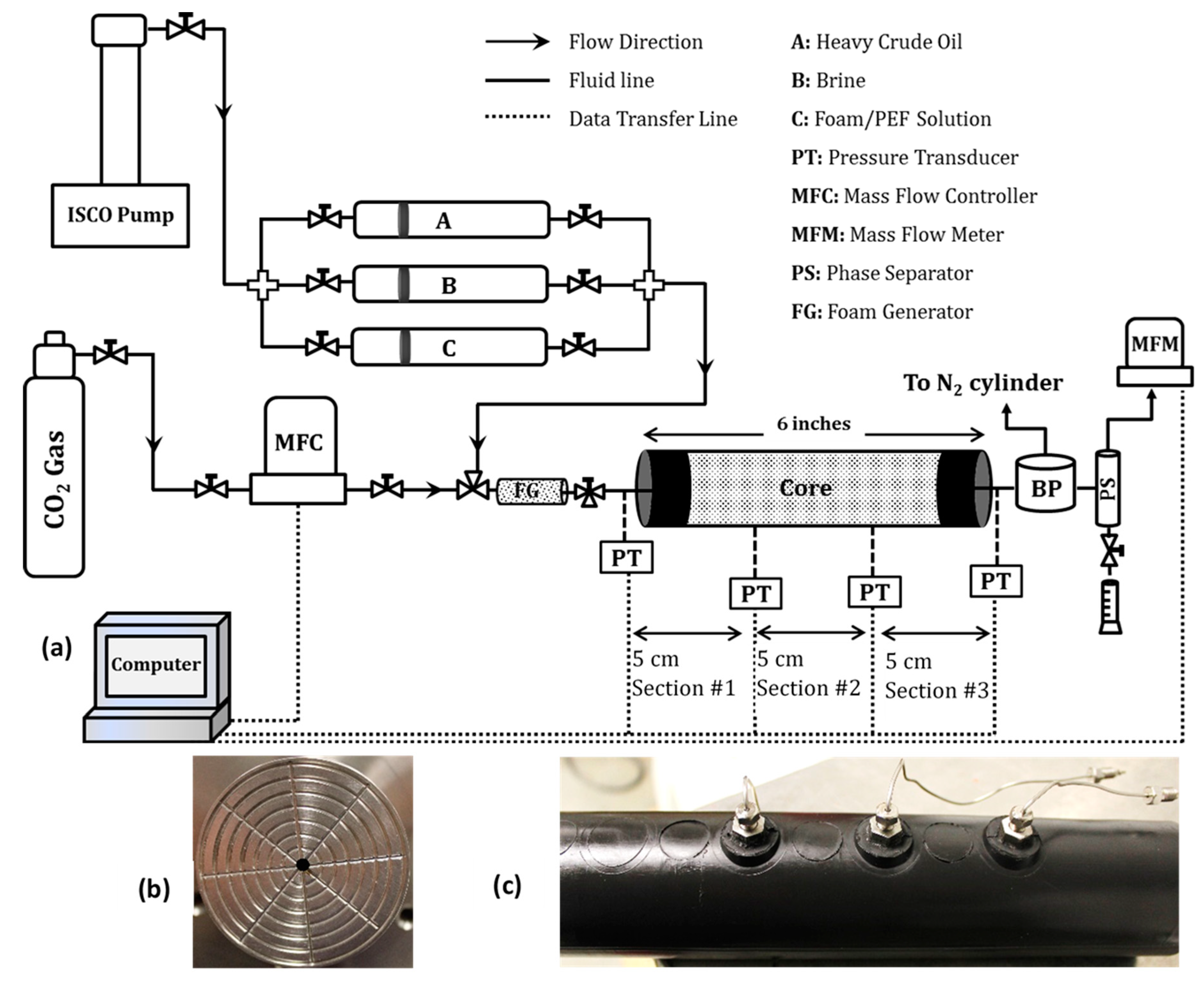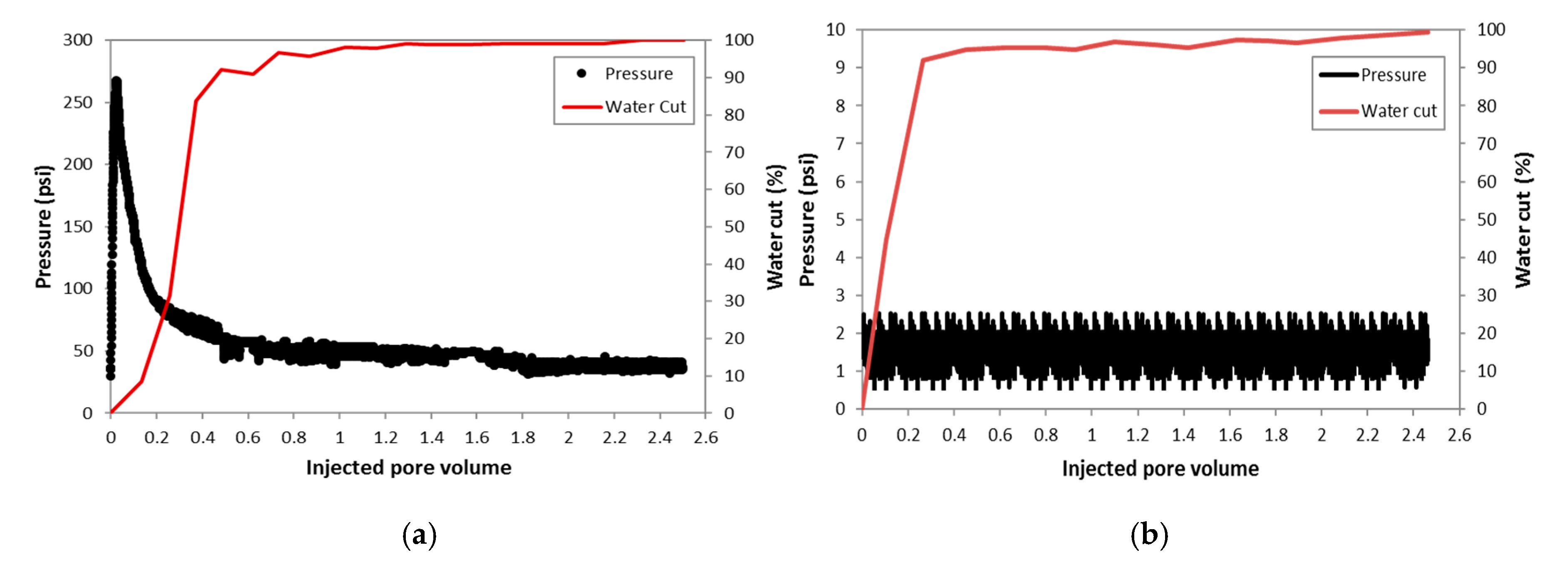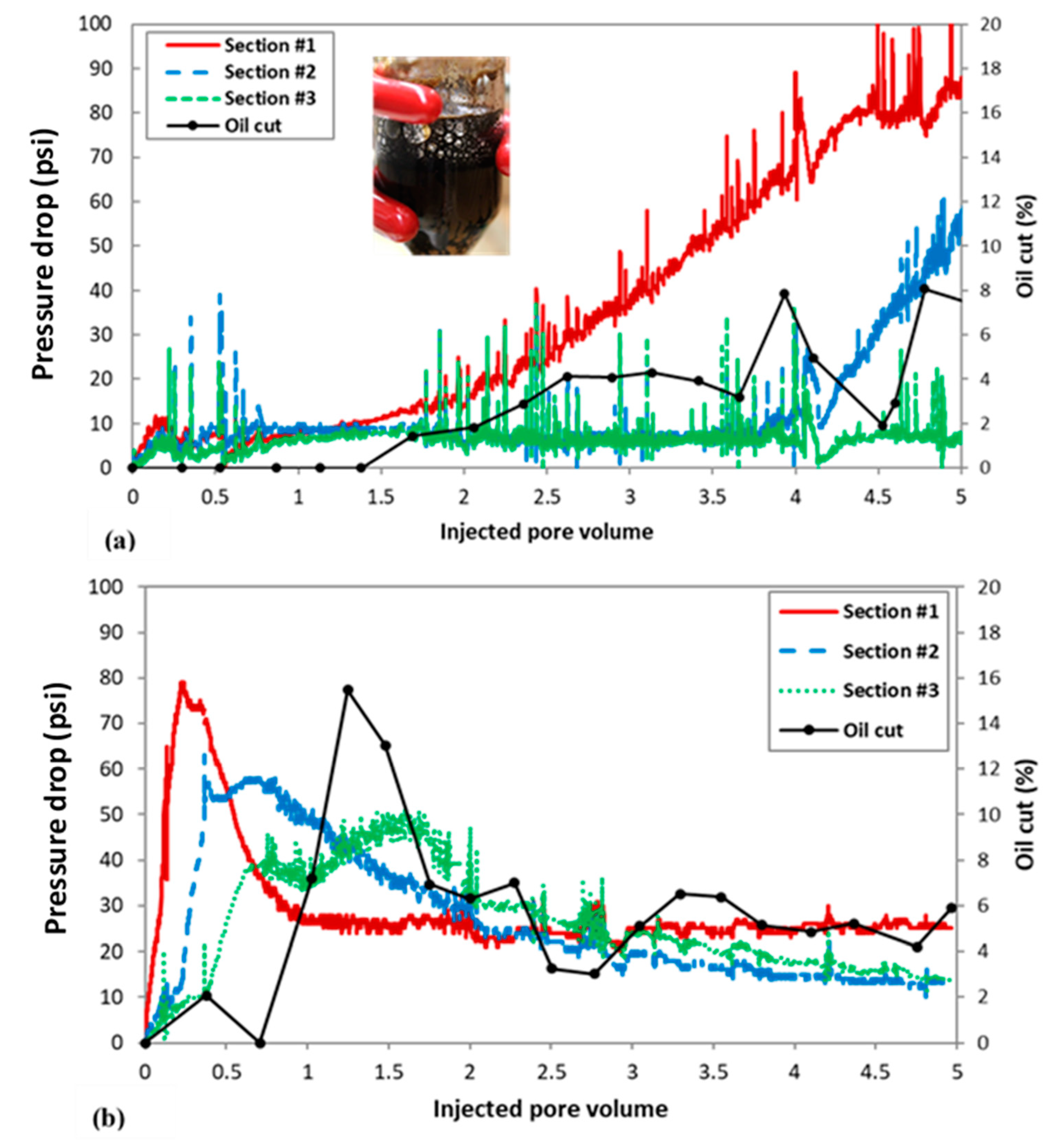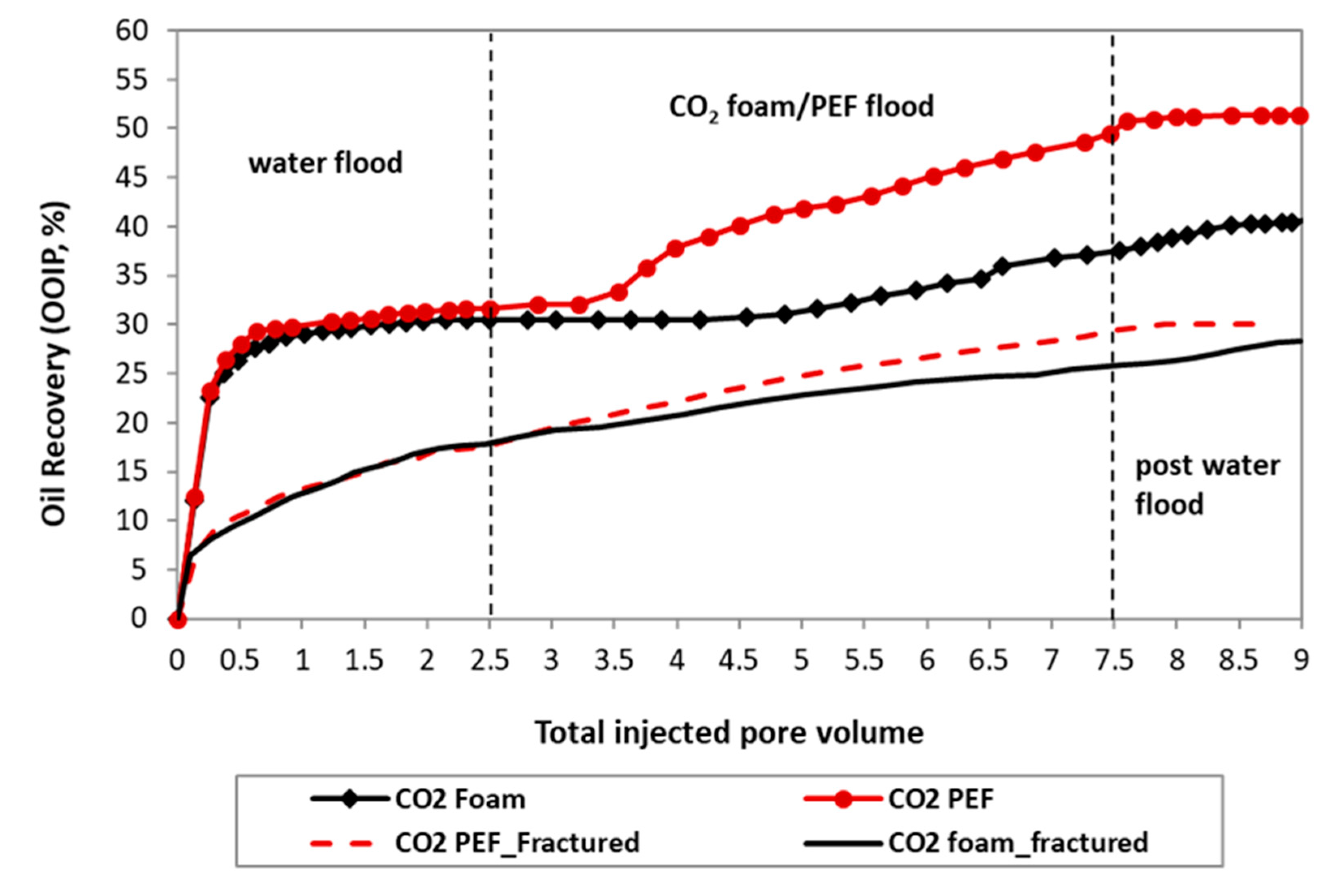CO2 Foam and CO2 Polymer Enhanced Foam for Heavy Oil Recovery and CO2 Storage
Abstract
1. Introduction
2. Experimental
2.1. Fluid Properties
2.2. Flow in Sandpack (Unconsolidated Porous Medium)
2.3. Flow in Rock Samples
3. Results
3.1. Static Performance of Foam and PEF in the Presence/Absence of Heavy Oil
3.2. Dynamic Performance of Foam and PEF in Unconsolidated Porous Medium
3.3. Dynamic Performance of Foam and PEF in Consolidated Porous Medium
3.3.1. Waterflood
3.3.2. CO2 Foam/PEF Flood
4. Discussions
4.1. Foam Flow in Unconsolidated Porous Media
4.2. Foam Flow in Consolidated Porous Media: Oil Recovery and CO2 Storage
5. Conclusions
- CO2 PEF showed better dynamic performance than that of CO2 foam in both unconsolidated porous media in terms of higher apparent viscosity, better oil tolerance, and consolidate porous media in terms of faster oil production, and a higher saturation of CO2 gas trapped in the porous media.
- In a homogenous rock sample, CO2 foam injection improved waterflood residual heavy oil recovery by 8% of OOIP.
- The addition of polymer to conventional CO2 foam (CO2 PEF) could significantly improve its performance for heavy oil recovery, especially in the homogeneous rock sample. CO2 PEF recovered about 26% and 11% of residual oil in the rock after the waterflooding process from the homogeneous and fractured rock, respectively.
- CO2 PEF showed a faster propagation rate than foam in the homogeneous porous media, demonstrating the higher dynamic stability of PEF. This also resulted in faster oil production and higher ultimate oil recovery after CO2 PEF injection.
- Injection pressure and amount of remained gas at the end of CO2 foam/PEF in the fractured core samples showed that there was no significant gas diversion into the matrix and most of the gas remained in the fractured area. Additional oil recovery from the fractured core was due to the liquid (surfactant/polymer) diversion into the matrix.
- Aside from improving heavy oil recovery, the addition of polymer increased the dynamic stability of foam bubbles in the presence of oil, reducing the CO2 gas production. At the end of CO2 PEF injection, CO2 gas occupied about 40% of pore volume, showing great potential for CO2 storage.
Author Contributions
Funding
Conflicts of Interest
References
- Trivedi, J.J.; Babadagli, T. Efficiency of diffusion controlled miscible displacement in fractured porous media. Transp. Porous Media 2007, 71, 379–394. [Google Scholar] [CrossRef]
- Trivedi, J.; Babadagli, T. Scaling miscible displacement in fractured porous media using dimensionless groups. J. Pet. Sci. Eng. 2008, 61, 58–66. [Google Scholar] [CrossRef]
- Trivedi, J.; Babadagli, T. Efficiency Analysis of Greenhouse Gas Sequestration during Miscible CO2Injection in Fractured Oil Reservoirs. Environ. Sci. Technol. 2008, 42, 5473–5479. [Google Scholar] [CrossRef] [PubMed]
- Trivedi, J.; Babadagli, T. Experimental and numerical modeling of the mass transfer between rock matrix and fracture. Chem. Eng. J. 2009, 146, 194–204. [Google Scholar] [CrossRef]
- Trivedi, J.J.; Babadagli, T. Oil Recovery and Sequestration Potential of Naturally Fractured Reservoirs During CO2 Injection. Energy Fuels 2009, 23, 4025–4036. [Google Scholar] [CrossRef]
- Trivedi, J.; Babadagli, T. Experimental Investigations on the Flow Dynamics and Abandonment Pressure for CO2 Sequestration and Oil Recovery in Artificially Fractured Cores. J. Can. Pet. Technol. 2010, 49, 22–27. [Google Scholar] [CrossRef]
- Moritis, G. Worldwide EOR Survey. Oil Gas. J. 2000, 98, 39–61. [Google Scholar]
- Moritis, G. Enhanced Oil Recovery. Oil Gas. J. 2002, 100, 43–47. [Google Scholar]
- Shaw, J.; Bachu, S. Screening, Evaluation, and Ranking of Oil Reservoirs Suitable for CO2-Flood EOR and Carbon Dioxide Sequestration. J. Can. Pet. Technol. 2002, 41. [Google Scholar] [CrossRef]
- Bachu, S.; Stewart, S. Geological Sequestration of Anthropogenic Carbon Dioxide in the Western Canada Sedimentary Basin: Suitability Analysis. J. Can. Pet. Technol. 2002, 41, 32–40. [Google Scholar] [CrossRef]
- Malik, Q.M.; Islam, M.R. CO2 Injection in the Weyburn Field of Canada: Optimization of Enhanced Oil Recovery and Greenhouse Gas Storage with Horizontal Wells. In SPE/DOE Improved Oil Recovery Symposium; Society of Petroleum Engineers: Tulsa, OK, USA, 2000. [Google Scholar]
- Rossen, W.R. Foams in Enhanced Oil Recovery. In Foams; Informa UK Limited: New York, NY, USA, 2017; pp. 413–464. [Google Scholar]
- Pope, G.; Lake, L.; Schechter, R. Annex 2: Reservoir Characterization and Enhanced Oil Recovery Research; Office of Scientific and Technical Information (OSTI): Austin, TX, USA, 1989. [Google Scholar]
- Alkan, H.; Goktekin, A.; Satman, A. A Laboratory Study of CO2-Foam Process for Bati Raman Field, Turkey; Society of Petroleum Engineers: San Antonio, TX, USA, 1991. [Google Scholar]
- Haugen, Å.; Fernø, M.A.; Graue, A.; Bertin, H.J. Experimental Study of Foam Flow in Fractured Oil-Wet Limestone for Enhanced Oil Recovery. SPE Reserv. Eval. Eng. 2012, 15, 218–228. [Google Scholar] [CrossRef]
- Henry, R.L.; Fisher, D.R.; Pennell, S.P.; Honnert, M.A. Field test of foam to reduce CO2 cycling. In SPE/DOE Improved Oil Recovery Symposium; Society of Petroleum Engineers: Tulsa, OK, USA, 1996. [Google Scholar]
- Holm, L.; Garrison, W.H. CO2 Diversion With Foam in an Immiscible CO2 Field Project. SPE Reserv. Eng. 1988, 3, 112–118. [Google Scholar] [CrossRef]
- Stevens, J.E.; Harpole, K.J.; Zornes, D.R.; Martin, F.D. CO2 Foam Field Verification Pilot Test at EVGSAU: Phase II—Foam Injection Design and Operating Plan. In SPE Annual Technical Conference and Exhibition; Society of Petroleum Engineers: Washington, DC, USA, 1992. [Google Scholar]
- Sanders, A.W.; Jones, R.M.; Rabie, A.; Putra, E.; Linroth, M.A.; Nguyen, Q.P. Implementation of a CO2 Foam Pilot Study in the SACROC Field: Performance Evaluation. In Proceedings of the SPE Annual Technical Conference and Exhibition, Society of Petroleum Engineers (SPE), San Antonio, TX, USA, 8–10 October 2012. [Google Scholar]
- Farajzadeh, R.; Andrianov, A.; Zitha, P.L.J. Investigation of Immiscible and Miscible Foam for Enhancing Oil Recovery. Ind. Eng. Chem. Res. 2010, 49, 1910–1919. [Google Scholar] [CrossRef]
- Haugen, Å.; Mani, N.; Svenningsen, S.; Brattekås, B.; Graue, A.; Ersland, G.; Fernø, M.A. Miscible and Immiscible Foam Injection for Mobility Control and EOR in Fractured Oil-Wet Carbonate Rocks. Transp. Porous Media 2014, 104, 109–131. [Google Scholar] [CrossRef]
- Chaturvedi, K.R.; Kumar, R.; Trivedi, J.J.; Sheng, J.J.; Sharma, T. Stable Silica Nanofluids of an Oilfield Polymer for Enhanced CO2 Absorption for Oilfield Applications. Energy Fuels 2018, 32, 12730–12741. [Google Scholar] [CrossRef]
- Chaturvedi, K.R.; Trivedi, J.; Sharma, T. Single-step silica nanofluid for improved carbon dioxide flow and reduced formation damage in porous media for carbon utilization. Energy 2020, 197, 117276. [Google Scholar] [CrossRef]
- Nikolov, A.D.; Wasan, D.T.; Huang, D.W.; Edwards, D.A. The Effect of Oil on Foam Stability: Mechanisms and Implications for Oil Displacement by Foam in Porous Media. In SPE Annual Technical Conference and Exhibition; Society of Petroleum Engineers: New Orleans, LA, USA, 1986. [Google Scholar]
- Li, R.F.; Yan, W.; Liu, S.; Hirasaki, G.; Miller, C.A. Foam Mobility Control for Surfactant Enhanced Oil Recovery. SPE J. 2010, 15, 928–942. [Google Scholar] [CrossRef]
- Simjoo, M.; Dong, Y.; Andrianov, A.; Talanana, M.; Zitha, P.L. A CT Scan Study of Immiscible Foam Flow in Porous Media for EOR. In Proceedings of the SPE EOR Conference at Oil and Gas West Asia, Society of Petroleum Engineers (SPE), Muscat, Oman, 16–18 April 2012. [Google Scholar]
- Ashoori, E.; Marchesin, D.; Rossen, W.R. Multiple Foam States and Long-Distance Foam Propagation in EOR Displacements. SPE J. 2012, 17, 1–231. [Google Scholar] [CrossRef]
- Telmadarreie, A.; Trivedi, J. Post-Surfactant CO2 Foam/Polymer-Enhanced Foam Flooding for Heavy Oil Recovery: Pore-Scale Visualization in Fractured Micromodel. Transp. Porous Media 2016, 113, 717–733. [Google Scholar] [CrossRef]
- Telmadarreie, A.; Trivedi, J.J. New Insight on Carbonate-Heavy-Oil Recovery: Pore-Scale Mechanisms of Post-Solvent Carbon Dioxide Foam/Polymer-Enhanced-Foam Flooding. SPE J. 2016, 21, 1655–1668. [Google Scholar] [CrossRef]
- Telmadarreie, A.; Trivedi, J. Evaluation of foam generated with the hydrocarbon solvent for extra-heavy oil recovery from fractured porous media: Pore-scale visualization. J. Pet. Sci. Eng. 2017, 157, 1170–1178. [Google Scholar] [CrossRef]
- Samuel, S.R.; Kuru, E.; Trivedi, J.J. Design and Development of Aqueous Colloidal Gas Aphrons for Enhanced Oil Recovery Applications. In SPE Symposium on Improved Oil Recovery; Society of Petroleum Engineers: Tulsa, OK, USA, 2012. [Google Scholar]
- Telmadarreie, A.; Doda, A.; Trivedi, J.J.; Kuru, E.; Choi, P. CO2 Microbubbles -A Potential Fluid for Enhanced Oil Recovery: Bulk and Porous Media Studies. J. Pet. Sci. Eng. 2016, 138, 160–173. [Google Scholar] [CrossRef]
- Dai, Z.; Middleton, R.; Viswanathan, H.S.; Fessenden-Rahn, J.; Bauman, J.; Pawar, R.; Lee, S.-Y.; McPherson, B. An Integrated Framework for Optimizing CO2 Sequestration and Enhanced Oil Recovery. Environ. Sci. Technol. Lett. 2013, 1, 49–54. [Google Scholar] [CrossRef]
- Ghomian, Y.; Pope, G.; Sepehrnoori, K. Hysteresis and Field-Scale Optimization of WAG Injection for Coupled CO2-EOR and Sequestration. In SPE Symposium on Improved Oil Recovery; Society of Petroleum Engineers: Tulsa, OK, USA, 2008. [Google Scholar]
- Telmadarreie, A.; Trivedi, J.J. Insight on Foam/Polymer Enhanced Foam Flooding for Improving Heavy Oil Sweep Efficiency; World Heavy Oil Congress: Edmonton, AB, Canada, 2015. [Google Scholar]
- Telmadarreie, A.; Trivedi, J. Static and Dynamic Performance of Wet Foam and Polymer-Enhanced Foam in the Presence of Heavy Oil. Colloids Interfaces 2018, 2, 38. [Google Scholar] [CrossRef]











| EOR Method | Rock Type | Fractured | Matrix Ø (%) | Matrix K (D) | Flow Rates (cc/min) | µoil (cp) | Soi ** | |
|---|---|---|---|---|---|---|---|---|
| ql | qg | |||||||
| CO2 Foam | Sandstone | No | 24.3 | 0.27 | 0.25 | 1 | 670 | 82.7 |
| CO2 PEF | Sandstone | No | 23.6 | 0.22 | 0.25 | 1 | 670 | 82.2 |
| CO2 Foam | Sandstone | Yes | 24.4 | 0.25 * | 0.25 | 1 | 670 | 76.7 |
| CO2 PEF | Sandstone | Yes | 24.1 | 0.25 * | 0.25 | 1 | 670 | 70.8 |
| CO2 PEF | Carbonate | Yes | 20 | 0.2 * | 0.25 | 1 | 670 | 70 |
Publisher’s Note: MDPI stays neutral with regard to jurisdictional claims in published maps and institutional affiliations. |
© 2020 by the authors. Licensee MDPI, Basel, Switzerland. This article is an open access article distributed under the terms and conditions of the Creative Commons Attribution (CC BY) license (http://creativecommons.org/licenses/by/4.0/).
Share and Cite
Telmadarreie, A.; Trivedi, J.J. CO2 Foam and CO2 Polymer Enhanced Foam for Heavy Oil Recovery and CO2 Storage. Energies 2020, 13, 5735. https://doi.org/10.3390/en13215735
Telmadarreie A, Trivedi JJ. CO2 Foam and CO2 Polymer Enhanced Foam for Heavy Oil Recovery and CO2 Storage. Energies. 2020; 13(21):5735. https://doi.org/10.3390/en13215735
Chicago/Turabian StyleTelmadarreie, Ali, and Japan J Trivedi. 2020. "CO2 Foam and CO2 Polymer Enhanced Foam for Heavy Oil Recovery and CO2 Storage" Energies 13, no. 21: 5735. https://doi.org/10.3390/en13215735
APA StyleTelmadarreie, A., & Trivedi, J. J. (2020). CO2 Foam and CO2 Polymer Enhanced Foam for Heavy Oil Recovery and CO2 Storage. Energies, 13(21), 5735. https://doi.org/10.3390/en13215735





